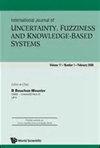Performance Metrics on Hyperspectral Images in Fuzzy Contextual Convolutional Neural Network for Food Quality Analyzer
IF 1
4区 计算机科学
Q4 COMPUTER SCIENCE, ARTIFICIAL INTELLIGENCE
International Journal of Uncertainty Fuzziness and Knowledge-Based Systems
Pub Date : 2023-08-01
DOI:10.1142/s0218488523500320
引用次数: 2
Abstract
The quality of food and the safety of consumer is one of the major essential things in our day-to-day life. To ensure the quality of foods through their various attributes, different types of methods have been introduced. In this proposed method, three underlying blocks namely Hyperspectral Food Image Context Extractor (HFICE), Hyperspectral Context Fuzzy Classifier (HCFC) and CNN for Food Quality Analyzer (CFQA). Hyperspectral Food Image Context Extractor module is used as the preprocess to get food attributes such as texture, color, size, shape and molecular particulars. Hyperspectral Context Fuzzy Classifier module identifies a particular part of the food (zone entity) is whether carbohydrate, fat, protein, water or unusable core. CNN for Food Quality Analyzer module uses a Tuned Convolutional layer, Heuristic Activation Operation, Parallel Element Merge Layer and a regular Fully Connected Layer. Indian Pines, Salinas and Pavia are the benchmark dataset to evaluate hyperspectral image-based machine learning procedures. These datasets are used along with a dedicated Chicken meat HSI dataset is used in the training and testing process. Results are obtained that about 7.86% of average values in various essential evaluation metrics such as performance metrics such as accuracy, precision, sensitivity and specificity have improved when compared to existing state of the art results.基于模糊上下文卷积神经网络的食品质量分析仪高光谱图像性能评价
食品质量和消费者的安全是我们日常生活中最重要的事情之一。为了通过食品的各种属性来保证其质量,引入了不同类型的方法。该方法采用高光谱食品图像上下文提取器(HFICE)、高光谱上下文模糊分类器(HCFC)和CNN用于食品质量分析仪(CFQA)三个底层模块。使用高光谱食品图像上下文提取模块作为预处理,获取食品的纹理、颜色、大小、形状和分子特征等属性。高光谱上下文模糊分类器模块识别食物的特定部分(区域实体)是碳水化合物、脂肪、蛋白质、水还是不可用的核心。CNN食品质量分析仪模块使用了一个调谐卷积层,启发式激活操作,并行元素合并层和一个规则的完全连接层。Indian Pines, Salinas和Pavia是评估基于高光谱图像的机器学习程序的基准数据集。这些数据集与专用的鸡肉HSI数据集一起用于训练和测试过程。结果表明,准确度、精密度、灵敏度、特异性等性能指标与现有技术水平相比,各项基本评价指标的平均值提高了约7.86%。
本文章由计算机程序翻译,如有差异,请以英文原文为准。
求助全文
约1分钟内获得全文
求助全文
来源期刊
CiteScore
2.70
自引率
0.00%
发文量
48
审稿时长
13.5 months
期刊介绍:
The International Journal of Uncertainty, Fuzziness and Knowledge-Based Systems is a forum for research on various methodologies for the management of imprecise, vague, uncertain or incomplete information. The aim of the journal is to promote theoretical or methodological works dealing with all kinds of methods to represent and manipulate imperfectly described pieces of knowledge, excluding results on pure mathematics or simple applications of existing theoretical results. It is published bimonthly, with worldwide distribution to researchers, engineers, decision-makers, and educators.

 求助内容:
求助内容: 应助结果提醒方式:
应助结果提醒方式:


